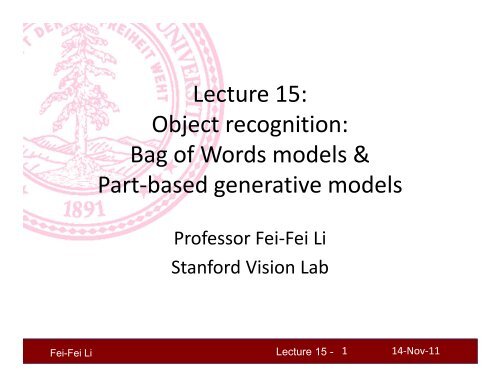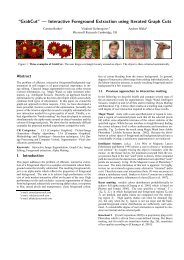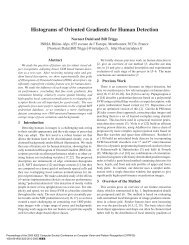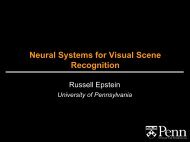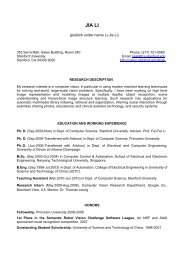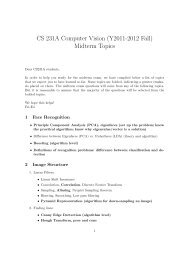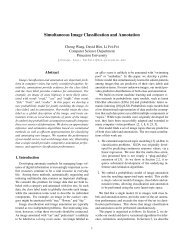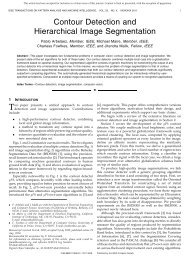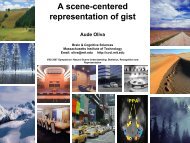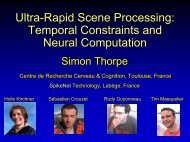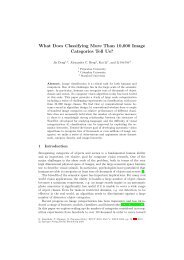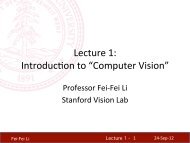Lecture 15 - Stanford Vision Lab
Lecture 15 - Stanford Vision Lab
Lecture 15 - Stanford Vision Lab
You also want an ePaper? Increase the reach of your titles
YUMPU automatically turns print PDFs into web optimized ePapers that Google loves.
<strong>Lecture</strong> <strong>15</strong>:<br />
Object recognition:<br />
Bag of Words models &<br />
Part‐based generative models<br />
Professor Fei‐Fei Li<br />
<strong>Stanford</strong> <strong>Vision</strong> <strong>Lab</strong><br />
Fei-Fei Li<br />
<strong>Lecture</strong> <strong>15</strong> -<br />
1<br />
14‐Nov‐11
Basic issues<br />
• Representation<br />
– How to represent an object category; which<br />
classification scheme?<br />
• Learning<br />
– How to learn the classifier, given training data<br />
• Recognition<br />
– How the classifier is to be used on novel data<br />
Fei-Fei Li<br />
<strong>Lecture</strong> <strong>15</strong> -<br />
2<br />
14‐Nov‐11
What we will learn today?<br />
• Bag of Words model (Problem Set 4 (Q2))<br />
– Basic representation<br />
– Different learning and recognition algorithms<br />
• Constellation model<br />
– Weakly supervised training<br />
– One‐shot learning (supplementary materials)<br />
• (Problem Set 4 (Q1))<br />
Fei-Fei Li<br />
<strong>Lecture</strong> <strong>15</strong> -<br />
3<br />
14‐Nov‐11
Part 1: Bag‐of‐words models<br />
This segment is based on the tutorial “Recognizing and Learning<br />
Object Categories: Year 2007”, by Prof L. Fei‐Fei, A. Torralba, and R. Fergus<br />
Fei-Fei Li<br />
<strong>Lecture</strong> <strong>15</strong> -<br />
4<br />
14‐Nov‐11
Related works<br />
• Early “bag of words” models: mostly texture<br />
recognition<br />
– Cula & Dana, 2001; Leung & Malik 2001; Mori, Belongie & Malik, 2001;<br />
Schmid 2001; Varma & Zisserman, 2002, 2003; Lazebnik, Schmid &<br />
Ponce, 2003;<br />
• Hierarchical Bayesian models for documents (pLSA,<br />
LDA, etc.)<br />
– Hoffman 1999; Blei, Ng & Jordan, 2004; Teh, Jordan, Beal & Blei, 2004<br />
• Object categorization<br />
– Csurka, Bray, Dance & Fan, 2004; Sivic, Russell, Efros, Freeman &<br />
Zisserman, 2005; Sudderth, Torralba, Freeman & Willsky, 2005;<br />
• Natural scene categorization<br />
– Vogel & Schiele, 2004; Fei‐Fei & Perona, 2005; Bosch, Zisserman &<br />
Munoz, 2006<br />
Fei-Fei Li<br />
<strong>Lecture</strong> <strong>15</strong> -<br />
5<br />
14‐Nov‐11
Object<br />
Bag of ‘words’<br />
Fei-Fei Li<br />
<strong>Lecture</strong> <strong>15</strong> -<br />
6<br />
14‐Nov‐11
Analogy to documents<br />
Of all the sensory impressions proceeding to<br />
the brain, the visual experiences are the<br />
dominant ones. Our perception of the world<br />
around us is based essentially on the<br />
messages that reach the brain from our eyes.<br />
For a long time it was thought that the retinal<br />
image was transmitted sensory, point brain, by point to visual<br />
centers in the brain; the cerebral cortex was a<br />
visual, perception,<br />
movie screen, so to speak, upon which the<br />
image in retinal, the eye was cerebral projected. Through cortex, the<br />
discoveries of eye, Hubel cell, and Wiesel optical we now<br />
know that behind the origin of the visual<br />
perception in the nerve, brain there image is a considerably<br />
more complicated Hubel, course of Wiesel events. By<br />
following the visual impulses along their path<br />
to the various cell layers of the optical cortex,<br />
Hubel and Wiesel have been able to<br />
demonstrate that the message about the<br />
image falling on the retina undergoes a stepwise<br />
analysis in a system of nerve cells<br />
stored in columns. In this system each cell<br />
has its specific function and is responsible for<br />
a specific detail in the pattern of the retinal<br />
image.<br />
China is forecasting a trade surplus of $90bn<br />
(£51bn) to $100bn this year, a threefold<br />
increase on 2004's $32bn. The Commerce<br />
Ministry said the surplus would be created by<br />
a predicted 30% jump in exports to $750bn,<br />
compared with a 18% rise in imports to<br />
$660bn. The figures China, are likely trade, to further<br />
annoy the<br />
surplus,<br />
US, which has<br />
commerce,<br />
long argued that<br />
China's exports are unfairly helped by a<br />
deliberately exports, undervalued imports, yuan. Beijing US,<br />
agrees the yuan, surplus bank, is too high, domestic, but says the<br />
yuan is only one factor. Bank of China<br />
governor Zhou foreign, Xiaochuan increase,<br />
said the country<br />
also needed to do trade, more to value boost domestic<br />
demand so more goods stayed within the<br />
country. China increased the value of the<br />
yuan against the dollar by 2.1% in July and<br />
permitted it to trade within a narrow band, but<br />
the US wants the yuan to be allowed to trade<br />
freely. However, Beijing has made it clear that<br />
it will take its time and tread carefully before<br />
allowing the yuan to rise further in value.<br />
Fei-Fei Li<br />
<strong>Lecture</strong> <strong>15</strong> -<br />
7<br />
14‐Nov‐11
definition of “BoW”<br />
– Independent features<br />
face bike violin<br />
Fei-Fei Li<br />
<strong>Lecture</strong> <strong>15</strong> -<br />
8<br />
14‐Nov‐11
definition of “BoW”<br />
– Independent features<br />
– histogram representation<br />
codewords dictionary<br />
Fei-Fei Li<br />
<strong>Lecture</strong> <strong>15</strong> -<br />
9<br />
14‐Nov‐11
Representation<br />
recognition<br />
feature detection<br />
& representation<br />
codewords dictionary<br />
image representation<br />
learning<br />
category models<br />
(and/or) classifiers<br />
Fei-Fei Li<br />
<strong>Lecture</strong> <strong>15</strong> -<br />
10<br />
category<br />
decision<br />
14‐Nov‐11
1.Feature detection and representation<br />
Fei-Fei Li<br />
<strong>Lecture</strong> <strong>15</strong> -<br />
11<br />
14‐Nov‐11
1.Feature detection and representation<br />
• Regular grid<br />
– Vogel & Schiele, 2003<br />
– Fei‐Fei & Perona, 2005<br />
Fei-Fei Li<br />
<strong>Lecture</strong> <strong>15</strong> -<br />
12<br />
14‐Nov‐11
1.Feature detection and representation<br />
• Regular grid<br />
– Vogel & Schiele, 2003<br />
– Fei‐Fei & Perona, 2005<br />
• Interest point detector<br />
– Csurka, et al. 2004<br />
– Fei‐Fei & Perona, 2005<br />
– Sivic, et al. 2005<br />
Fei-Fei Li<br />
<strong>Lecture</strong> <strong>15</strong> -<br />
13<br />
14‐Nov‐11
1.Feature detection and representation<br />
• Regular grid<br />
– Vogel & Schiele, 2003<br />
– Fei‐Fei & Perona, 2005<br />
• Interest point detector<br />
– Csurka, Bray, Dance & Fan, 2004<br />
– Fei‐Fei & Perona, 2005<br />
– Sivic, Russell, Efros, Freeman & Zisserman, 2005<br />
• Other methods<br />
– Random sampling (Vidal‐Naquet & Ullman, 2002)<br />
– Segmentation based patches (Barnard, Duygulu, Forsyth,<br />
de Freitas, Blei, Jordan, 2003)<br />
Fei-Fei Li<br />
<strong>Lecture</strong> <strong>15</strong> -<br />
14<br />
14‐Nov‐11
1.Feature detection and representation<br />
Compute<br />
SIFT<br />
descriptor<br />
[Lowe’99]<br />
Normalize<br />
patch<br />
Detect patches<br />
[Mikojaczyk and Schmid ’02]<br />
[Mata, Chum, Urban & Pajdla, ’02]<br />
[Sivic & Zisserman, ’03]<br />
Slide credit: Josef Sivic<br />
Fei-Fei Li<br />
<strong>Lecture</strong> <strong>15</strong> -<br />
<strong>15</strong><br />
14‐Nov‐11
1.Feature detection and representation<br />
…<br />
Fei-Fei Li<br />
<strong>Lecture</strong> <strong>15</strong> -<br />
16<br />
14‐Nov‐11
2. Codewords dictionary formation<br />
…<br />
Fei-Fei Li<br />
<strong>Lecture</strong> <strong>15</strong> -<br />
17<br />
14‐Nov‐11
2. Codewords dictionary formation<br />
…<br />
Cluster center<br />
= code word<br />
Clustering/<br />
vector quantization<br />
Fei-Fei Li<br />
<strong>Lecture</strong> <strong>15</strong> -<br />
18<br />
14‐Nov‐11
2. Codewords dictionary formation<br />
Fei-Fei et al. 2005<br />
Fei-Fei Li<br />
<strong>Lecture</strong> <strong>15</strong> -<br />
19<br />
14‐Nov‐11
Image patch examples of codewords<br />
Sivic et al. 2005<br />
Fei-Fei Li<br />
<strong>Lecture</strong> <strong>15</strong> -<br />
20<br />
14‐Nov‐11
Visual vocabularies: Issues<br />
• How to choose vocabulary size?<br />
– Too small: visual words not representative of all patches<br />
– Too large: quantization artifacts, overfitting<br />
• Computational efficiency<br />
– Vocabulary trees<br />
(Nister & Stewenius, 2006)<br />
Fei-Fei Li<br />
<strong>Lecture</strong> <strong>15</strong> -<br />
21<br />
14‐Nov‐11
3. Bag of word representation<br />
• Nearest neighbors assignment<br />
• K‐D tree search strategy<br />
Codewords dictionary<br />
Fei-Fei Li<br />
<strong>Lecture</strong> <strong>15</strong> -<br />
22<br />
14‐Nov‐11
3. Bag of word representation<br />
frequency<br />
….<br />
codewords<br />
Codewords dictionary<br />
Fei-Fei Li<br />
<strong>Lecture</strong> <strong>15</strong> -<br />
23<br />
14‐Nov‐11
Representation<br />
1.<br />
feature detection<br />
& representation<br />
2.<br />
codewords dictionary<br />
image representation<br />
3.<br />
Fei-Fei Li<br />
<strong>Lecture</strong> <strong>15</strong> -<br />
24<br />
14‐Nov‐11
Learning and Recognition<br />
codewords dictionary<br />
category models<br />
(and/or) classifiers<br />
Fei-Fei Li<br />
<strong>Lecture</strong> <strong>15</strong> -<br />
25<br />
category<br />
decision<br />
14‐Nov‐11
Learning and Recognition<br />
1. Discriminative method:<br />
-NN<br />
- SVM<br />
2.Generative method:<br />
- graphical models<br />
category models<br />
(and/or) classifiers<br />
Fei-Fei Li<br />
<strong>Lecture</strong> <strong>15</strong> -<br />
26<br />
14‐Nov‐11
Discriminative<br />
classifiers<br />
category models<br />
Model space<br />
…<br />
…<br />
…<br />
Class 1<br />
Class N<br />
Fei-Fei Li<br />
<strong>Lecture</strong> <strong>15</strong> -<br />
27<br />
14‐Nov‐11
Discriminative<br />
classifiers<br />
Query image<br />
Model space<br />
Winning class: pink<br />
Fei-Fei Li<br />
<strong>Lecture</strong> <strong>15</strong> -<br />
28<br />
14‐Nov‐11
Nearest Neighbors<br />
classifier<br />
Query image<br />
Model space<br />
Winning class: pink<br />
• Assign label of nearest training data point to each test data point<br />
Fei-Fei Li<br />
<strong>Lecture</strong> <strong>15</strong> -<br />
29<br />
14‐Nov‐11
K- Nearest Neighbors<br />
classifier<br />
Query image<br />
Model space<br />
Winning class: pink<br />
• For a new point, find the k closest points from training data<br />
• <strong>Lab</strong>els of the k points “vote” to classify<br />
• Works well provided there is lots of data and the distance function is good<br />
Fei-Fei Li<br />
<strong>Lecture</strong> <strong>15</strong> -<br />
30<br />
14‐Nov‐11
K- Nearest Neighbors<br />
classifier<br />
from Duda et al.<br />
• Voronoi partitioning of feature space for 2‐category 2‐D and 3‐D data<br />
• For k dimensions: k‐D tree = space‐partitioning data structure for organizing points in a<br />
k‐dimensional space<br />
• Enable efficient search<br />
• Nice tutorial: http://www.cs.umd.edu/class/spring2002/cmsc420‐0401/pbasic.pdf<br />
Fei-Fei Li<br />
<strong>Lecture</strong> <strong>15</strong> -<br />
31<br />
14‐Nov‐11
Functions for comparing histograms<br />
• L1 distance<br />
D<br />
( h<br />
N<br />
1<br />
, h<br />
2<br />
) | h1<br />
( i)<br />
h<br />
2<br />
( i)<br />
|<br />
i 1<br />
• χ 2 distance<br />
D<br />
( h<br />
1<br />
,<br />
h<br />
2<br />
)<br />
<br />
N<br />
<br />
<br />
h1<br />
( i)<br />
h ( i)<br />
<br />
<br />
h<br />
h<br />
i 1 1<br />
2<br />
2<br />
<br />
( i)<br />
( i)<br />
2<br />
• Quadratic distance (cross‐bin)<br />
<br />
D ( h1 , h<br />
2<br />
) Aij<br />
( h1<br />
( i)<br />
h<br />
2<br />
( j ))<br />
i ,<br />
j<br />
2<br />
Jan Puzicha, Yossi Rubner, Carlo Tomasi, Joachim M. Buhmann: Empirical Evaluation of<br />
Dissimilarity Measures for Color and Texture. ICCV 1999<br />
Fei-Fei Li<br />
<strong>Lecture</strong> <strong>15</strong> -<br />
32<br />
14‐Nov‐11
Learning and Recognition<br />
1. Discriminative method:<br />
-NN<br />
- SVM<br />
2.Generative method:<br />
- graphical models<br />
Fei-Fei Li<br />
<strong>Lecture</strong> <strong>15</strong> -<br />
33<br />
14‐Nov‐11
Discriminative classifiers<br />
(linear classifier)<br />
category models<br />
Model space<br />
…<br />
…<br />
…<br />
Class 1<br />
Class N<br />
Fei-Fei Li<br />
<strong>Lecture</strong> <strong>15</strong> -<br />
34<br />
14‐Nov‐11
Support vector machines<br />
• Find hyperplane that maximizes the margin between the positive and<br />
negative examples<br />
Support vectors: x i<br />
w<br />
b 1<br />
| x<br />
w<br />
b |<br />
Distance between point i<br />
and hyperplane: || w ||<br />
Margin = 2 / ||w||<br />
Solution:<br />
y x i i i i<br />
Support vectors<br />
Credit slide: S. Lazebnik<br />
Margin<br />
w<br />
w x b y x x b<br />
Classification function (decision boundary):<br />
i<br />
i<br />
i<br />
i<br />
Fei-Fei Li<br />
<strong>Lecture</strong> <strong>15</strong> -<br />
35<br />
14‐Nov‐11
Support vector machines<br />
• Classification<br />
w<br />
x b y x x<br />
i<br />
i<br />
i<br />
i<br />
<br />
b<br />
Test point<br />
if<br />
x w<br />
<br />
b<br />
<br />
0<br />
<br />
class<br />
1<br />
if<br />
x w<br />
<br />
b<br />
<br />
0<br />
<br />
class<br />
2<br />
Margin<br />
C. Burges, A Tutorial on Support Vector Machines for Pattern Recognition, Data Mining and Knowledge Discovery, 1998<br />
Fei-Fei Li<br />
<strong>Lecture</strong> <strong>15</strong> -<br />
36<br />
14‐Nov‐11
Nonlinear SVMs<br />
•Datasets that are linearly separable work out great:<br />
•<br />
•<br />
0 x<br />
•But what if the dataset is just too hard?<br />
0 x<br />
• We can map it to a higher‐dimensional space:<br />
x 2<br />
0 x<br />
Slide credit: Andrew Moore<br />
Fei-Fei Li<br />
<strong>Lecture</strong> <strong>15</strong> -<br />
37<br />
14‐Nov‐11
Nonlinear SVMs<br />
• General idea: the original input space can always be mapped<br />
to some higher‐dimensional feature space where the<br />
training set is separable:<br />
Φ: x → φ(x)<br />
lifting transformation<br />
Slide credit: Andrew Moore<br />
Fei-Fei Li<br />
<strong>Lecture</strong> <strong>15</strong> -<br />
38<br />
14‐Nov‐11
Nonlinear SVMs<br />
• Nonlinear decision boundary in the original feature<br />
space:<br />
<br />
i<br />
y<br />
i<br />
K ( x<br />
i<br />
, x )<br />
i<br />
<br />
b<br />
•The kernel K = product of the lifting transformation φ(x):<br />
K(x i ,x j j) = φ(x i ) · φ(x j )<br />
NOTE:<br />
•It is not required to compute φ(x) explicitly:<br />
•The kernel must satisfy the “Mercer inequality”<br />
C. Burges, A Tutorial on Support Vector Machines for Pattern Recognition, Data Mining and Knowledge Discovery, 1998<br />
Fei-Fei Li<br />
<strong>Lecture</strong> <strong>15</strong> -<br />
39<br />
14‐Nov‐11
Kernels for bags of features<br />
• Histogram intersection kernel:<br />
N<br />
<br />
I ( h1 , h<br />
2<br />
) min( h1<br />
( i),<br />
h<br />
2<br />
( i))<br />
i 1<br />
• Generalized Gaussian kernel:<br />
1<br />
K ( h , h<br />
2<br />
) exp D ( h1<br />
, h<br />
A<br />
<br />
2<br />
1 2<br />
)<br />
<br />
<br />
<br />
• D can be Euclidean distance, χ 2 distance etc…<br />
J. Zhang, M. Marszalek, S. Lazebnik, and C. Schmid, Local Features and Kernels for Classifcation of Texture and Object Categories: A<br />
Comprehensive Study, IJCV 2007<br />
Fei-Fei Li<br />
<strong>Lecture</strong> <strong>15</strong> -<br />
40<br />
14‐Nov‐11
Pyramid match kernel<br />
• Fast approximation of Earth Mover’s Distance<br />
• Weighted sum of histogram intersections at mutliple resolutions (linear in<br />
the number of features instead of cubic)<br />
K. Grauman and T. Darrell. The Pyramid Match Kernel: Discriminative Classification with Sets of Image Features, ICCV 2005.<br />
Fei-Fei Li<br />
<strong>Lecture</strong> <strong>15</strong> -<br />
41<br />
14‐Nov‐11
Spatial Pyramid Matching<br />
Beyond Bags of Features: Spatial Pyramid Matching for Recognizing Natural Scene Categories. S. Lazebnik, C. Schmid, and J. Ponce. CVPR 2006<br />
Fei-Fei Li<br />
<strong>Lecture</strong> <strong>15</strong> -<br />
42<br />
14‐Nov‐11
What about multi‐class SVMs?<br />
• No “definitive” multi‐class SVM formulation<br />
• In practice, we have to obtain a multi‐class SVM by combining<br />
multiple two‐class SVMs<br />
• One vs. others<br />
– Traning: learn an SVM for each class vs. the others<br />
– Testing: apply each SVM to test example and assign to it the class of<br />
the SVM that returns the highest decision value<br />
• One vs. one<br />
– Training: learn an SVM for each pair of classes<br />
– Testing: each learned SVM “votes” for a class to assign to the test<br />
example<br />
Credit slide: S. Lazebnik<br />
Fei-Fei Li<br />
<strong>Lecture</strong> <strong>15</strong> -<br />
43<br />
14‐Nov‐11
SVMs: Pros and cons<br />
• Pros<br />
– Many publicly available SVM packages:<br />
http://www.kernel‐machines.org/software<br />
– Kernel‐based framework is very powerful, flexible<br />
– SVMs work very well in practice, even with very small training sample sizes<br />
• Cons<br />
– No “direct” multi‐class SVM, must combine two‐class SVMs<br />
– Computation, memory<br />
• During training time, must compute matrix of kernel values for every pair of<br />
examples<br />
• Learning can take a very long time for large‐scale problems<br />
Fei-Fei Li<br />
<strong>Lecture</strong> <strong>15</strong> -<br />
44<br />
14‐Nov‐11
Object recognition results<br />
• ETH‐80 database of 8 object<br />
classes<br />
(Eichhorn and Chapelle 2004)<br />
• Features:<br />
– Harris detector<br />
– PCA‐SIFT descriptor, d=10<br />
Kernel Complexity Recognition rate<br />
Match [Wallraven et al.] 84%<br />
Bhattacharyya affinity<br />
[Kondor & Jebara]<br />
85%<br />
Pyramid match 84%<br />
Slide credit: Kristen Grauman<br />
<strong>Lecture</strong> <strong>15</strong> -<br />
14‐Nov‐11
Discriminative models<br />
Nearest neighbor<br />
Neural networks<br />
10 6 examples<br />
Shakhnarovich, Viola, Darrell 2003<br />
Berg, Berg, Malik 2005...<br />
LeCun, Bottou, Bengio, Haffner 1998<br />
Rowley, Baluja, Kanade 1998<br />
…<br />
Support Vector Machines<br />
Latent SVM<br />
Structural SVM<br />
Boosting<br />
Guyon, Vapnik, Heisele,<br />
Serre, Poggio…<br />
Felzenszwalb 00<br />
Ramanan 03…<br />
Viola, Jones 2001,<br />
Torralba et al. 2004,<br />
Opelt et al. 2006,…<br />
Source: Vittorio Ferrari, Kristen Grauman, Antonio Torralba<br />
Fei-Fei Li<br />
<strong>Lecture</strong> <strong>15</strong> -<br />
46<br />
14‐Nov‐11
Learning and Recognition<br />
1. Discriminative method:<br />
‐ NN<br />
‐ SVM<br />
2.Generative method:<br />
‐ graphical models<br />
Model the probability distribution that produces a given bag of<br />
features<br />
Fei-Fei Li<br />
<strong>Lecture</strong> <strong>15</strong> -<br />
47<br />
14‐Nov‐11
Generative models<br />
1. Naïve Bayes classifier<br />
– Csurka Bray, Dance & Fan, 2004<br />
2. Hierarchical Bayesian text models (pLSA and<br />
LDA)<br />
– Background: Hoffman 2001, Blei, Ng & Jordan, 2004<br />
– Object categorization: Sivic et al. 2005, Sudderth et al.<br />
2005<br />
– Natural scene categorization: Fei‐Fei et al. 2005<br />
Fei-Fei Li<br />
<strong>Lecture</strong> <strong>15</strong> -<br />
48<br />
14‐Nov‐11
Some notations<br />
• w: a collection of all N codewords in the image<br />
w = [w1,w2,…,wN]<br />
• c: category of the image<br />
Fei-Fei Li<br />
<strong>Lecture</strong> <strong>15</strong> -<br />
49<br />
14‐Nov‐11
the Naïve Bayes model<br />
c<br />
w<br />
N<br />
Graphical model<br />
Posterior =<br />
probability<br />
that image I is<br />
of category c<br />
p( c | w)<br />
p( c)<br />
p(<br />
w | c)<br />
Prior prob. of<br />
the object classes<br />
Image likelihood<br />
given the class<br />
<strong>Lecture</strong> <strong>15</strong> -<br />
14‐Nov‐11
the Naïve Bayes model<br />
c<br />
w<br />
N<br />
Graphical model<br />
c<br />
<br />
arg max<br />
c<br />
p( c | w)<br />
<br />
p( c)<br />
p(<br />
w | c)<br />
<br />
p(<br />
c)<br />
N<br />
<br />
n1<br />
p(<br />
w n<br />
| c)<br />
Object class<br />
decision<br />
Likelihood of ith visual word<br />
given the class<br />
Estimated by empirical frequencies of code<br />
words in images from a given class<br />
<strong>Lecture</strong> <strong>15</strong> -<br />
14‐Nov‐11
Csurka et al. 2004<br />
Fei-Fei Li<br />
<strong>Lecture</strong> <strong>15</strong> -<br />
52<br />
14‐Nov‐11
Csurka et al. 2004<br />
Fei-Fei Li<br />
<strong>Lecture</strong> <strong>15</strong> -<br />
53<br />
14‐Nov‐11
Other generative BoW models<br />
• Hierarchical Bayesian topic models (e.g. pLSA<br />
and LDA)<br />
– Object categorization: Sivic et al. 2005, Sudderth et al. 2005<br />
– Natural scene categorization: Fei‐Fei et al. 2005<br />
Fei-Fei Li<br />
<strong>Lecture</strong> <strong>15</strong> -<br />
54<br />
14‐Nov‐11
Generative vs discriminative<br />
• Discriminative methods<br />
– Computationally efficient & fast<br />
• Generative models<br />
– Convenient for weakly‐ or un‐supervised, incremental<br />
training<br />
– Prior information<br />
– Flexibility in modeling parameters<br />
Fei-Fei Li<br />
<strong>Lecture</strong> <strong>15</strong> -<br />
55<br />
14‐Nov‐11
Weakness of BoW the models<br />
• No rigorous geometric information of the<br />
object components<br />
• It’s intuitive to most of us that objects are<br />
made of parts –no such information<br />
• Not extensively tested yet for<br />
– View point invariance<br />
– Scale invariance<br />
• Segmentation and localization unclear<br />
Fei-Fei Li<br />
<strong>Lecture</strong> <strong>15</strong> -<br />
56<br />
14‐Nov‐11
What we will learn today?<br />
• Bag of Words model (Problem Set 4 (Q2))<br />
– Basic representation<br />
– Different learning and recognition algorithms<br />
• Constellation model<br />
– Weakly supervised training<br />
– One‐shot learning (supplementary materials)<br />
• (Problem Set 4 (Q1))<br />
Fei-Fei Li<br />
<strong>Lecture</strong> <strong>15</strong> -<br />
57<br />
14‐Nov‐11
Model: Parts and Structure<br />
Fei-Fei Li<br />
<strong>Lecture</strong> <strong>15</strong> -<br />
58<br />
14‐Nov‐11
Parts and Structure Literature<br />
• Fischler & Elschlager 1973<br />
• Yuille ‘91<br />
• Brunelli & Poggio ‘93<br />
• Lades, v.d. Malsburg et al. ‘93<br />
• Cootes, Lanitis, Taylor et al. ‘95<br />
• Amit & Geman ‘95, ‘99<br />
• et al. Perona ‘95, ‘96, ’98, ’00, ‘03<br />
• Huttenlocher et al. ’00<br />
• Agarwal & Roth ’02<br />
etc…<br />
Fei-Fei Li<br />
<strong>Lecture</strong> <strong>15</strong> -<br />
59<br />
14‐Nov‐11
The Constellation Model<br />
T. Leung<br />
Representation<br />
Shape statistics – F&G ’95<br />
Affine invariant shape – CVPR ‘98<br />
M. Burl<br />
Detection<br />
CVPR ‘96<br />
ECCV ‘98<br />
M. Weber<br />
M. Welling<br />
Unsupervised Learning<br />
ECCV ‘00<br />
Multiple views - F&G ’00<br />
Discovering categories - CVPR ’00<br />
R. Fergus<br />
Joint shape & appearance learning<br />
Generic feature detectors<br />
CVPR ’03<br />
Polluted datasets - ECCV ‘04<br />
L. Fei-Fei<br />
One-Shot Learning<br />
Incremental learning<br />
ICCV ’03<br />
CVPR ‘04<br />
Fei-Fei Li<br />
<strong>Lecture</strong> <strong>15</strong> -<br />
60<br />
14‐Nov‐11
Deformations<br />
A<br />
B<br />
C<br />
D<br />
Fei-Fei Li<br />
<strong>Lecture</strong> <strong>15</strong> -<br />
61<br />
14‐Nov‐11
Presence / Absence of Features<br />
occlusion<br />
Fei-Fei Li<br />
<strong>Lecture</strong> <strong>15</strong> -<br />
62<br />
14‐Nov‐11
Background clutter<br />
Fei-Fei Li<br />
<strong>Lecture</strong> <strong>15</strong> -<br />
63<br />
14‐Nov‐11
Foreground model<br />
Generative probabilistic model<br />
Clutter model<br />
Gaussian shape pdf Prob. of detection Uniform shape pdf # detections<br />
0.8 0.75<br />
Assumptions: (a) Clutter independent of foreground detections<br />
(b) Clutter detections independent of each other<br />
Example<br />
1. Object Part Positions<br />
2. Part Absence 3a. N false detect<br />
0.9<br />
p Poisson (N 1 | 1 )<br />
p Poisson (N 2 | 2 )<br />
p Poisson (N 3 | 3 )<br />
3b. Position f. detect<br />
N 1<br />
N 2<br />
N 3<br />
Fei-Fei Li<br />
<strong>Lecture</strong> <strong>15</strong> -<br />
64<br />
14‐Nov‐11
Learning Models `Manually’<br />
• Obtain set of training images<br />
• Choose parts<br />
• <strong>Lab</strong>el parts by hand, train detectors<br />
• Learn model from labeled parts<br />
Fei-Fei Li<br />
<strong>Lecture</strong> <strong>15</strong> -<br />
65<br />
14‐Nov‐11
Recognition<br />
1. Run part detectors exhaustively over image<br />
1<br />
1<br />
2<br />
3<br />
1<br />
2<br />
2<br />
1<br />
2<br />
3<br />
4<br />
3<br />
h<br />
0N<br />
<br />
0N<br />
0N<br />
<br />
0N<br />
1<br />
2<br />
3<br />
4<br />
<br />
<br />
<br />
<br />
<br />
<br />
e.g.<br />
h<br />
2<br />
<br />
3<br />
0<br />
<br />
2<br />
2. Try different combinations of detections in model<br />
- Allow detections to be missing (occlusion)<br />
3. Pick hypothesis which maximizes:<br />
p(<br />
Data | Object,<br />
Hyp)<br />
p(<br />
Data | Clutter,<br />
Hyp)<br />
4. If ratio is above threshold then, instance detected<br />
Fei-Fei Li<br />
<strong>Lecture</strong> <strong>15</strong> -<br />
66<br />
14‐Nov‐11
So far…..<br />
• Representation<br />
– Joint model of part locations<br />
– Ability to deal with background clutter and occlusions<br />
• Learning<br />
– Manual construction of part detectors<br />
– Estimate parameters of shape density<br />
• Recognition<br />
– Run part detectors over image<br />
– Try combinations of features in model<br />
– Use efficient search techniques to make fast<br />
Fei-Fei Li<br />
<strong>Lecture</strong> <strong>15</strong> -<br />
67<br />
14‐Nov‐11
Unsupervised Learning<br />
Weber & Welling et. al.<br />
Fei-Fei Li<br />
<strong>Lecture</strong> <strong>15</strong> -<br />
68<br />
14‐Nov‐11
(Semi) Unsupervised learning<br />
•Know if image contains object or not<br />
•But no segmentation of object or manual selection of features<br />
Fei-Fei Li<br />
<strong>Lecture</strong> <strong>15</strong> -<br />
69<br />
14‐Nov‐11
Unsupervised detector training - 1<br />
10<br />
10<br />
• Highly textured neighborhoods are selected automatically<br />
• produces 100-1000 patterns per image<br />
Fei-Fei Li<br />
<strong>Lecture</strong> <strong>15</strong> -<br />
70<br />
14‐Nov‐11
Unsupervised detector training - 2<br />
“Pattern Space” (100+ dimensions)<br />
Fei-Fei Li<br />
<strong>Lecture</strong> <strong>15</strong> -<br />
71<br />
14‐Nov‐11
Unsupervised detector training - 3<br />
100-1000 images ~100 detectors<br />
Fei-Fei Li<br />
<strong>Lecture</strong> <strong>15</strong> -<br />
72<br />
14‐Nov‐11
Learning<br />
• Take training images. Pick set of detectors. Apply detectors.<br />
• Task:<br />
Estimation of model parameters<br />
• Chicken and Egg type problem, since we initially know neither:<br />
- Model parameters<br />
- Assignment of regions to foreground / background<br />
• Let the assignments be a hidden variable and use EM algorithm to<br />
learn them and the model parameters<br />
Fei-Fei Li<br />
<strong>Lecture</strong> <strong>15</strong> -<br />
73<br />
14‐Nov‐11
ML using EM<br />
1. Current estimate<br />
pdf<br />
Large P<br />
2. Assign probabilities to constellations<br />
...<br />
Image 1 Image 2 Image i<br />
Small P<br />
3. Use probabilities as weights to re-estimate parameters. Example: <br />
Large P x + Small P x<br />
+ … =<br />
new estimate of <br />
Fei-Fei Li<br />
<strong>Lecture</strong> <strong>15</strong> -<br />
74<br />
14‐Nov‐11
Detector Selection<br />
•Try out different combinations of detectors<br />
(Greedy search)<br />
Model 1<br />
Choice 1<br />
Parameter<br />
Estimation<br />
Choice 2<br />
Parameter<br />
Estimation<br />
Model 2<br />
Detectors (100)<br />
Predict / measure model performance<br />
(validation set or directly from model)<br />
Fei-Fei Li<br />
<strong>Lecture</strong> <strong>15</strong> -<br />
75<br />
14‐Nov‐11
Frontal Views of Faces<br />
• 200 Images (100 training, 100 testing)<br />
• 30 people, different for training and testing<br />
Fei-Fei Li<br />
<strong>Lecture</strong> <strong>15</strong> -<br />
76<br />
14‐Nov‐11
Learned face model<br />
Pre-selected Parts<br />
Test Error: 6% (4 Parts)<br />
Parts in Model<br />
Model Foreground pdf<br />
Sample Detection<br />
Fei-Fei Li<br />
<strong>Lecture</strong> <strong>15</strong> -<br />
77<br />
14‐Nov‐11
Face images<br />
Fei-Fei Li<br />
<strong>Lecture</strong> <strong>15</strong> -<br />
78<br />
14‐Nov‐11
Background images<br />
Fei-Fei Li<br />
<strong>Lecture</strong> <strong>15</strong> -<br />
79<br />
14‐Nov‐11
Preselected Parts<br />
Car from Rear<br />
Test Error: 13% (5 Parts)<br />
Parts in Model<br />
Model Foreground pdf<br />
Sample Detection<br />
Fei-Fei Li<br />
<strong>Lecture</strong> <strong>15</strong> -<br />
80<br />
14‐Nov‐11
Detections of Cars<br />
Fei-Fei Li<br />
<strong>Lecture</strong> <strong>15</strong> -<br />
81<br />
14‐Nov‐11
Background Images<br />
Fei-Fei Li<br />
<strong>Lecture</strong> <strong>15</strong> -<br />
82<br />
14‐Nov‐11
3D Object recognition – Multiple mixture<br />
components<br />
Fei-Fei Li<br />
<strong>Lecture</strong> <strong>15</strong> -<br />
83<br />
14‐Nov‐11
3D Orientation Tuning<br />
100<br />
Orientation Tuning<br />
% Correct<br />
95<br />
90<br />
85<br />
80<br />
75<br />
70<br />
65<br />
60<br />
55<br />
% Correct<br />
50<br />
0 20 40 60 80 100<br />
angle in degrees<br />
Frontal<br />
Profile<br />
Fei-Fei Li<br />
<strong>Lecture</strong> <strong>15</strong> -<br />
84<br />
14‐Nov‐11
So far (2)…..<br />
• Representation<br />
– Multiple mixture components for different viewpoints<br />
• Learning<br />
– Now semi-unsupervised<br />
– Automatic construction and selection of part detectors<br />
– Estimation of parameters using EM<br />
• Recognition<br />
– As before<br />
• Issues:<br />
-Learning is slow (many combinations of detectors)<br />
-Appearance learnt first, then shape<br />
Fei-Fei Li<br />
<strong>Lecture</strong> <strong>15</strong> -<br />
85<br />
14‐Nov‐11
• Speed of learning<br />
Issues<br />
– Slow (many combinations of detectors)<br />
• Appearance learnt first, then shape<br />
– Difficult to learn part that has stable location but<br />
variable appearance<br />
– Each detector is used as a cross-correlation filter,<br />
giving a hard definition of the part’s appearance<br />
• Would like a fully probabilistic representation of<br />
the object<br />
Fei-Fei Li<br />
<strong>Lecture</strong> <strong>15</strong> -<br />
86<br />
14‐Nov‐11
Object categorization<br />
Fergus et. al.<br />
CVPR ’03, IJCV ‘06<br />
Fei-Fei Li<br />
<strong>Lecture</strong> <strong>15</strong> -<br />
87<br />
14‐Nov‐11
Detection & Representation of regions<br />
• Find regions within image<br />
• Use salient region operator<br />
(Kadir & Brady 01)<br />
Location<br />
(x,y) coords. of region centre<br />
Scale<br />
Appearance<br />
Radius of region (pixels)<br />
Fei-Fei Li<br />
Normalize<br />
11x11 patch<br />
<strong>Lecture</strong> <strong>15</strong> -<br />
Projection onto<br />
PCA basis<br />
Gives representation of appearance in low-dimensional vector space<br />
88<br />
c 1<br />
c 2<br />
14‐Nov‐11<br />
………..<br />
c <strong>15</strong>
•Kadir & Brady saliency region detector<br />
Motorbikes example<br />
Fei-Fei Li<br />
<strong>Lecture</strong> <strong>15</strong> -<br />
89<br />
14‐Nov‐11
Generative probabilistic model (2)<br />
Foreground model<br />
Gaussian shape pdf<br />
Gaussian part appearance pdf<br />
based on Burl, Weber et al. [ECCV ’98, ’00]<br />
Gaussian<br />
relative scale pdf<br />
log(scale)<br />
Prob. of detection<br />
Clutter model<br />
0.8 0.75 0.9<br />
Uniform shape pdf<br />
Gaussian background<br />
appearance pdf<br />
Uniform<br />
relative scale pdf<br />
log(scale)<br />
Poission pdf on #<br />
detections<br />
Fei-Fei Li<br />
<strong>Lecture</strong> <strong>15</strong> -<br />
90<br />
14‐Nov‐11
Motorbikes<br />
Samples from appearance model<br />
Fei-Fei Li<br />
<strong>Lecture</strong> <strong>15</strong> -<br />
91<br />
14‐Nov‐11
Recognized Motorbikes<br />
Fei-Fei Li<br />
<strong>Lecture</strong> <strong>15</strong> -<br />
92<br />
14‐Nov‐11
Background images evaluated with<br />
motorbike model<br />
Fei-Fei Li<br />
<strong>Lecture</strong> <strong>15</strong> -<br />
93<br />
14‐Nov‐11
Frontal faces<br />
Fei-Fei Li<br />
<strong>Lecture</strong> <strong>15</strong> -<br />
94<br />
14‐Nov‐11
Airplanes<br />
Fei-Fei Li<br />
<strong>Lecture</strong> <strong>15</strong> -<br />
95<br />
14‐Nov‐11
Spotted cats<br />
Fei-Fei Li<br />
<strong>Lecture</strong> <strong>15</strong> -<br />
96<br />
14‐Nov‐11
Summary of results<br />
Dataset<br />
Fixed scale<br />
experiment<br />
Scale invariant<br />
experiment<br />
Motorbikes 7.5 6.7<br />
Faces 4.6 4.6<br />
Airplanes 9.8 7.0<br />
Cars (Rear) <strong>15</strong>.2 9.7<br />
Spotted cats 10.0 10.0<br />
% equal error rate<br />
Note: Within each series, same settings used for all datasets<br />
Fei-Fei Li<br />
<strong>Lecture</strong> <strong>15</strong> -<br />
97<br />
14‐Nov‐11
Comparison to other methods<br />
Dataset Ours Others<br />
Motorbikes 7.5 16.0<br />
Weber et al.<br />
[ECCV ‘00]<br />
Faces 4.6 6.0 Weber<br />
Airplanes 9.8 32.0 Weber<br />
Cars (Side) 11.5 21.0<br />
Agarwal<br />
Roth<br />
[ECCV ’02]<br />
% equal error rate<br />
Fei-Fei Li<br />
<strong>Lecture</strong> <strong>15</strong> -<br />
98<br />
14‐Nov‐11
Why this design?<br />
• Generic features seem to well in finding consistent parts<br />
of the object<br />
• Some categories perform badly – different feature types<br />
needed<br />
• Why PCA representation?<br />
– Tried ICA, FLD, Oriented filter responses etc.<br />
– But PCA worked best<br />
• Fully probabilistic representation lets us use tools from<br />
machine learning community<br />
Fei-Fei Li<br />
<strong>Lecture</strong> <strong>15</strong> -<br />
99<br />
14‐Nov‐11
What we have learned today?<br />
• Bag of Words model (Problem Set 4 (Q2))<br />
– Basic representation<br />
– Different learning and recognition algorithms<br />
• Constellation model<br />
– Weakly supervised training<br />
– One‐shot learning (supplementary materials)<br />
• (Problem Set 4 (Q1))<br />
Fei-Fei Li<br />
<strong>Lecture</strong> <strong>15</strong> -<br />
100<br />
14‐Nov‐11
Supplementary materials<br />
• One‐Shot learning using Constellation Model<br />
Fei-Fei Li<br />
<strong>Lecture</strong> <strong>15</strong> -<br />
101<br />
14‐Nov‐11
S. Savarese, 2003<br />
Fei-Fei Li<br />
<strong>Lecture</strong> <strong>15</strong> -<br />
102<br />
14‐Nov‐11
Fei-Fei Li <strong>Lecture</strong> <strong>15</strong> - 103 14‐Nov‐11<br />
P. Buegel, <strong>15</strong>62
One-Shot learning<br />
Fei-Fei et. al.<br />
ICCV ’03, PAMI ‘06<br />
Fei-Fei Li<br />
<strong>Lecture</strong> <strong>15</strong> -<br />
104<br />
14‐Nov‐11
Algorithm<br />
Burl, et al. Weber,<br />
et al. Fergus, et al.<br />
Training<br />
Examples<br />
200 ~ 400<br />
Categories<br />
Faces, Motorbikes,<br />
Spotted cats, Airplanes,<br />
Cars<br />
Viola et al. ~10,000 Faces<br />
Schneiderman, et<br />
al.<br />
~2,000 Faces, Cars<br />
Rowley<br />
et al.<br />
~500 Faces<br />
Fei-Fei Li<br />
<strong>Lecture</strong> <strong>15</strong> -<br />
105<br />
14‐Nov‐11
Number of training examples<br />
60<br />
50<br />
Generalisation performance<br />
6 part Motorbike model<br />
Test<br />
Train<br />
Classification error (%)<br />
40<br />
30<br />
20<br />
Previously<br />
10<br />
0<br />
1 2 3 4 5 6 7 8 9<br />
log 2<br />
(Training images)<br />
Fei-Fei Li<br />
<strong>Lecture</strong> <strong>15</strong> -<br />
106<br />
14‐Nov‐11
How do we do better than what<br />
statisticians have told us?<br />
• Intuition 1: use Prior information<br />
• Intuition 2: make best use of training information<br />
Fei-Fei Li<br />
<strong>Lecture</strong> <strong>15</strong> -<br />
107<br />
14‐Nov‐11
Prior knowledge: means<br />
Appearance<br />
Shape<br />
Fei-Fei Li<br />
<strong>Lecture</strong> <strong>15</strong> -<br />
108<br />
14‐Nov‐11
Bayesian framework<br />
P(object | test, train) vs. P(clutter | test, train)<br />
Bayes Rule<br />
p( test | object, train ) p(object<br />
)<br />
Expansion by parametrization<br />
p(test<br />
| ,object)<br />
p(<br />
| object, train)<br />
d<br />
Fei-Fei Li<br />
<strong>Lecture</strong> <strong>15</strong> -<br />
109<br />
14‐Nov‐11
Bayesian framework<br />
P(object | test, train) vs. P(clutter | test, train)<br />
Bayes Rule<br />
p( test | object, train ) p(object<br />
)<br />
Expansion by parametrization<br />
p(test<br />
| ,object)<br />
p(<br />
| object, train)<br />
d<br />
Previous Work:<br />
<br />
<br />
ML<br />
<br />
<br />
Fei-Fei Li<br />
<strong>Lecture</strong> <strong>15</strong> -<br />
110<br />
14‐Nov‐11
Bayesian framework<br />
P(object | test, train) vs. P(clutter | test, train)<br />
Bayes Rule<br />
p( test | object, train ) p(object<br />
)<br />
Expansion by parametrization<br />
p(test<br />
| ,object)<br />
p(<br />
| object, train)<br />
d<br />
One-Shot learning: p train<br />
,<br />
object p<br />
<br />
<br />
Fei-Fei Li<br />
<strong>Lecture</strong> <strong>15</strong> -<br />
111<br />
14‐Nov‐11
model () space<br />
Model Structure<br />
Each object model <br />
Gaussian shape pdf<br />
Gaussian part<br />
appearance pdf<br />
1<br />
n<br />
2<br />
Fei-Fei Li<br />
<strong>Lecture</strong> <strong>15</strong> -<br />
112<br />
14‐Nov‐11
model () space<br />
Model Structure<br />
Each object model <br />
Gaussian shape pdf<br />
Gaussian part<br />
appearance pdf<br />
1<br />
n<br />
2<br />
model distribution: p()<br />
• conjugate distribution of p(train|,object)<br />
Fei-Fei Li<br />
<strong>Lecture</strong> <strong>15</strong> - 113<br />
14‐Nov‐11
p<br />
Learning Model Distribution<br />
object, train p train , object p<br />
<br />
•use Prior information<br />
• Bayesian learning<br />
• marginalize over theta<br />
Variational EM (Attias, Hinton, Minka, etc.)<br />
Fei-Fei Li<br />
<strong>Lecture</strong> <strong>15</strong> -<br />
114<br />
14‐Nov‐11
Variational EM<br />
Random<br />
initialization<br />
new ’s<br />
E-Step<br />
M-Step<br />
new estimate<br />
of p(|train)<br />
Fei-Fei Li<br />
prior knowledge of p()<br />
<strong>Lecture</strong> <strong>15</strong> - 1<strong>15</strong> 14‐Nov‐11
Experiments<br />
Training:<br />
1- 6 randomly<br />
drawn images<br />
Testing:<br />
50 fg/ 50 bg images<br />
object present/absent<br />
Datasets<br />
faces<br />
airplanes<br />
spotted cats<br />
motorbikes<br />
Fei-Fei Li<br />
<strong>Lecture</strong> <strong>15</strong> -<br />
116<br />
14‐Nov‐11
Faces<br />
Motorbikes<br />
Airplanes<br />
Spotted cats<br />
Fei-Fei Li<br />
<strong>Lecture</strong> <strong>15</strong> -<br />
117<br />
14‐Nov‐11
Experiments: obtaining priors<br />
airplanes<br />
model () space<br />
spotted cats<br />
faces<br />
motorbikes<br />
Fei-Fei Li<br />
<strong>Lecture</strong> <strong>15</strong> -<br />
118<br />
14‐Nov‐11
Experiments: obtaining priors<br />
airplanes<br />
model () space<br />
faces<br />
spotted cats<br />
motorbikes<br />
Fei-Fei Li<br />
<strong>Lecture</strong> <strong>15</strong> -<br />
119<br />
14‐Nov‐11
Number of training examples<br />
Fei-Fei Li<br />
<strong>Lecture</strong> <strong>15</strong> -<br />
120<br />
14‐Nov‐11
Number of training examples<br />
Fei-Fei Li<br />
<strong>Lecture</strong> <strong>15</strong> -<br />
121<br />
14‐Nov‐11
Number of training examples<br />
Fei-Fei Li<br />
<strong>Lecture</strong> <strong>15</strong> -<br />
122<br />
14‐Nov‐11
Number of training examples<br />
Fei-Fei Li<br />
<strong>Lecture</strong> <strong>15</strong> -<br />
123<br />
14‐Nov‐11
Algorithm<br />
Training<br />
Examples<br />
Categories<br />
Results(e<br />
rror)<br />
Burl, et al. Weber,<br />
et al. Fergus, et al.<br />
200 ~ 400<br />
Faces, Motorbikes,<br />
Spotted cats, Airplanes,<br />
Cars<br />
5.6 - 10<br />
%<br />
Viola et al. ~10,000 Faces 7-21%<br />
Schneiderman, et<br />
al.<br />
~2,000 Faces, Cars 5.6 – 17%<br />
Rowley<br />
et al.<br />
~500 Faces<br />
7.5 –<br />
24.1%<br />
Bayesian<br />
One-Shot<br />
1 ~ 5<br />
Faces, Motorbikes,<br />
Spotted cats, Airplanes<br />
8 –<br />
<strong>15</strong> %<br />
Fei-Fei Li<br />
<strong>Lecture</strong> <strong>15</strong> -<br />
124<br />
14‐Nov‐11


